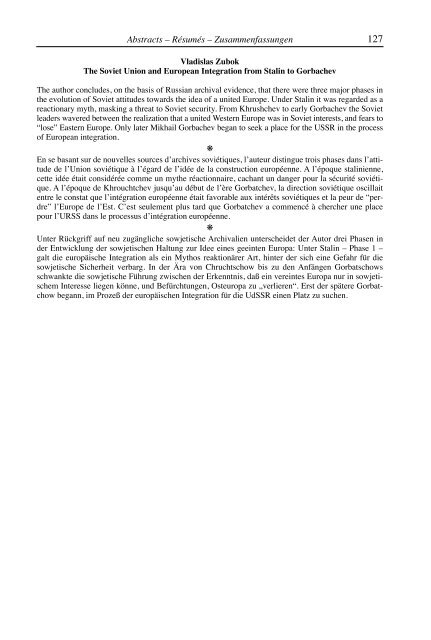journal of european integration history revue d'histoire de l ...
journal of european integration history revue d'histoire de l ...
journal of european integration history revue d'histoire de l ...
You also want an ePaper? Increase the reach of your titles
YUMPU automatically turns print PDFs into web optimized ePapers that Google loves.
Abstracts – Résumés – Zusammenfassungen 127<br />
Vladislas Zubok<br />
The Soviet Union and European Integration from Stalin to Gorbachev<br />
The author conclu<strong>de</strong>s, on the basis <strong>of</strong> Russian archival evi<strong>de</strong>nce, that there were three major phases in<br />
the evolution <strong>of</strong> Soviet attitu<strong>de</strong>s towards the i<strong>de</strong>a <strong>of</strong> a united Europe. Un<strong>de</strong>r Stalin it was regar<strong>de</strong>d as a<br />
reactionary myth, masking a threat to Soviet security. From Khrushchev to early Gorbachev the Soviet<br />
lea<strong>de</strong>rs wavered between the realization that a united Western Europe was in Soviet interests, and fears to<br />
“lose” Eastern Europe. Only later Mikhail Gorbachev began to seek a place for the USSR in the process<br />
<strong>of</strong> European <strong>integration</strong>.<br />
❋<br />
En se basant sur <strong>de</strong> nouvelles sources d’archives soviétiques, l’auteur distingue trois phases dans l’attitu<strong>de</strong><br />
<strong>de</strong> l’Union soviétique à l’égard <strong>de</strong> l’idée <strong>de</strong> la construction européenne. A l’époque stalinienne,<br />
cette idée était considérée comme un mythe réactionnaire, cachant un danger pour la sécurité soviétique.<br />
A l’époque <strong>de</strong> Khrouchtchev jusqu’au début <strong>de</strong> l’ère Gorbatchev, la direction soviétique oscillait<br />
entre le constat que l’intégration européenne était favorable aux intérêts soviétiques et la peur <strong>de</strong> “perdre”<br />
l’Europe <strong>de</strong> l’Est. C’est seulement plus tard que Gorbatchev a commencé à chercher une place<br />
pour l’URSS dans le processus d’intégration européenne.<br />
❋<br />
Unter Rückgriff auf neu zugängliche sowjetische Archivalien unterschei<strong>de</strong>t <strong>de</strong>r Autor drei Phasen in<br />
<strong>de</strong>r Entwicklung <strong>de</strong>r sowjetischen Haltung zur I<strong>de</strong>e eines geeinten Europa: Unter Stalin – Phase 1 –<br />
galt die europäische Integration als ein Mythos reaktionärer Art, hinter <strong>de</strong>r sich eine Gefahr für die<br />
sowjetische Sicherheit verbarg. In <strong>de</strong>r Ära von Chruchtschow bis zu <strong>de</strong>n Anfängen Gorbatschows<br />
schwankte die sowjetische Führung zwischen <strong>de</strong>r Erkenntnis, daß ein vereintes Europa nur in sowjetischem<br />
Interesse liegen könne, und Befürchtungen, Osteuropa zu „verlieren“. Erst <strong>de</strong>r spätere Gorbatchow<br />
begann, im Prozeß <strong>de</strong>r europäischen Integration für die UdSSR einen Platz zu suchen.

















